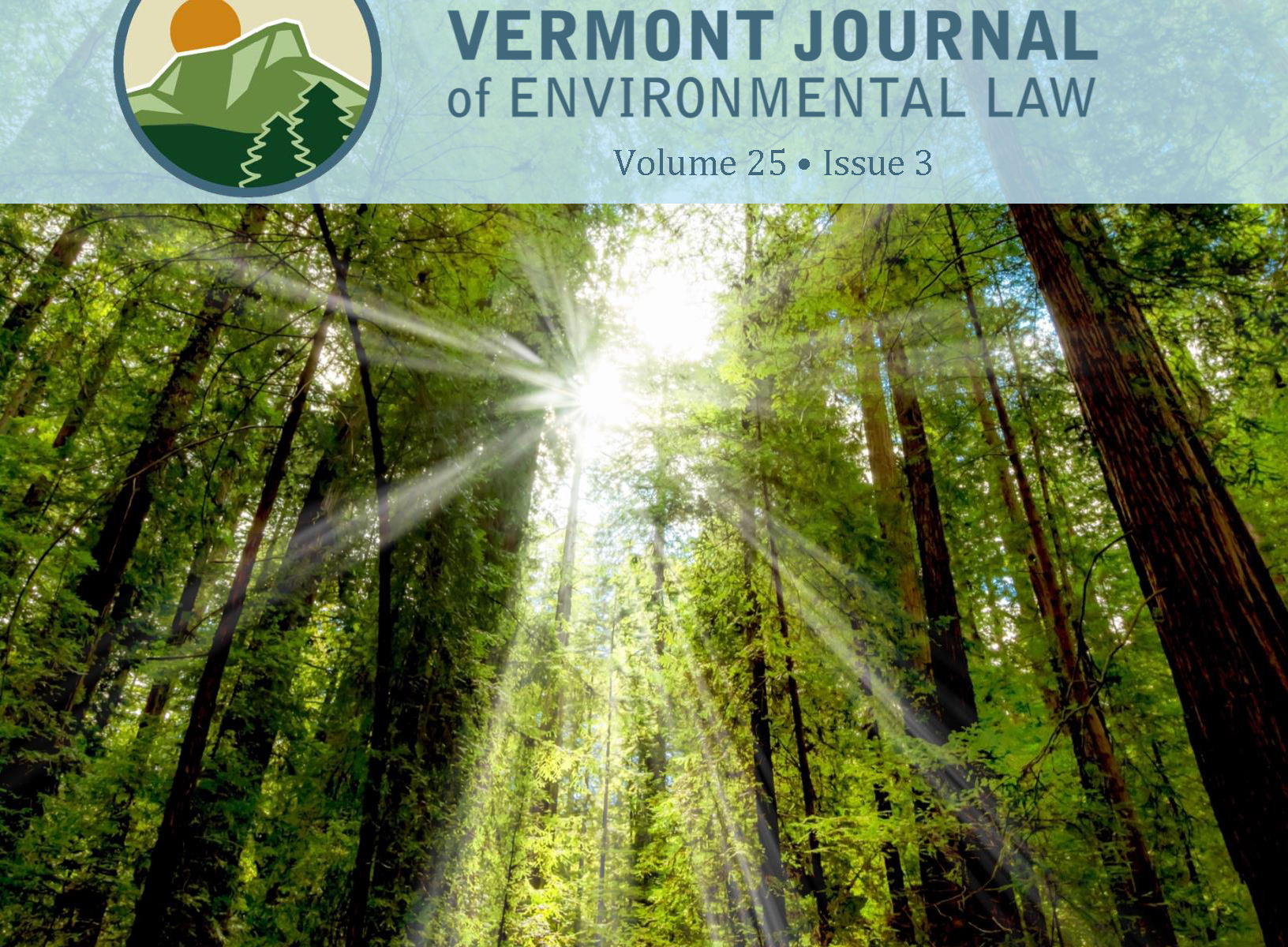
VJEL Newsroom
Published: Volume 25, Issue 3 of the Vermont Journal of Environmental Law
By VJEL
April 4, 2024
The Vermont Journal of Environmental Law (VJEL) is pleased to announce the publication of Volume 25, Issue 3. Issue 3 features two Articles and one student Note. Professor Mary Christina Wood’s article proposes Regional Frameworks to organize land-based, natural climate solutions for atmospheric carbon drawdown, emphasizing the need for global collaboration and financing. Professor Anastasia Telesetsky’s Article advocates for a communitarian approach to nature-based solutions (NBS), arguing that an economic rationale alone may dilute the effectiveness of NBS projects. The Article further suggests implementing an “ecological education and service” model akin to jury duty to foster public engagement. Finally, Elizabeth Beairsto’s Note discusses strategies for states to align a clean energy transition with equity and justice principles, highlighting legislative changes and offering recommendations for facilitating a just transition. VJEL publishes exclusively online, and this Issue may be accessed on our website by clicking this link to view our Volume 25, Issue 3 Publication or accessing our Volume 25 Publications from the navigation header.
Articles:
Sky Carbon Cleanup and Biodiversity Restoration: Devising Regional Frameworks
By Mary Christina Wood
Professor Wood’s Article proposes Regional Frameworks aimed at organizing the land-based, natural climate solutions (NCS) necessary to meet humanity’s need to reduce excess carbon in the atmosphere. The Article first explains the scientific need for atmospheric carbon drawdown. It then introduces a meta-strategy for catalyzing drawdowns worldwide by implementing an interlocking, “three-gear” approach comprised of (1) developing Regional Atmospheric Recovery Frameworks; (2) financing those Frameworks; and (3) organizing Regional Sky Trusts to carry out drawdown projects. The Article then outlines which components the Regional Frameworks should include and discusses significant stakeholders and contributors before summarizing ongoing efforts to develop such a framework in the Pacific Northwest region of the United States. Professor Wood concludes by proposing the establishment of Regional Atmospheric Recovery Institutes to sustain efforts at implementing NCS in a globally comprehensive and collaborative way.
By Anastasia Telesetsky
Professor Telesetsky’s Article summarizes the concept of nature-based solutions (NBS) and attempts to provide a novel solution to increase public engagement in NBS work. The Article begins by exploring the variety of ways in which NBS are characterized and then explains why that expansiveness of that definition dilutes the potential for effective financing of true NBS projects. In particular, the Article argues that NBS should not operate on a predominantly economic rationale but should instead incorporate communitarian principles of solidarity and “care ethics.” Professor Telesetsky concludes by outlining one potential approach for approaching NBS in a communitarian way: by implementing an “ecological education and service” mechanism of community participation modeled after the practice of jury duty.
Student Note:
By Elizabeth Beairsto: 3L at Vermont Law and Graduate School and VJEL’s Public Relations Editor.
Elizabeth Beairsto’s Note seeks to outline strategies for states to harmonize newfound opportunities to advance the clean energy transition with their ongoing obligations to uphold overarching principles of equity and justice. The Note begins by describing the complex energy “trilemma” of energy security, affordability, and environmental sustainability. Against this backdrop, it then describes the ways in which the legislative framework created by the Inflation Reduction Act of 2022 and Infrastructure Investment and Jobs Act of 2021 altered the clean energy landscape by providing novel opportunities for implementing clean energy. The Note concludes by summarizing certain strategies that states may undertake as they seek to develop legislation that helps facilitate the necessary just transition.
VJEL would like to thank the authors for their submissions, as well as the Editorial Staff for their hard work to produce Volume 25, Issue 3. Their contributions continue to add exemplary and accessible work to the environmental law field.

